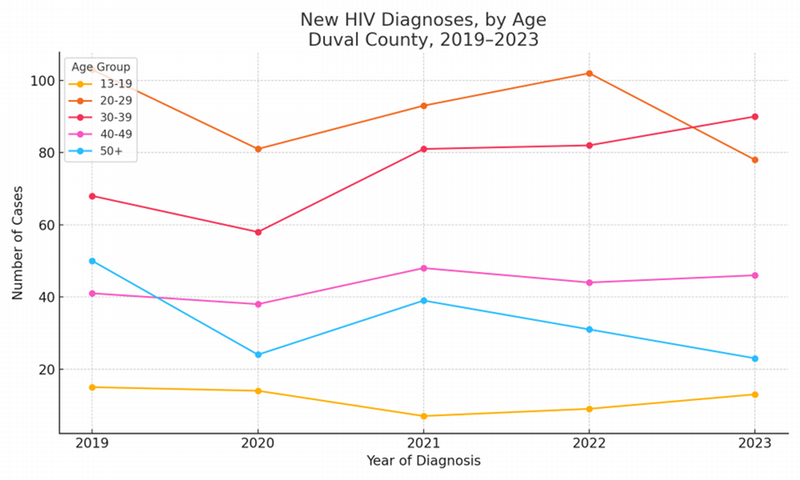STATISTICS

HIV surveillance reports disseminate data about HIV and AIDS. Examples of data include counts and rates of new HIV or AIDS diagnoses, the number of people living with HIV or AIDS, and the number of people who are receiving medical care to treat HIV.
Unless otherwise noted, the following surveillance report describes Duval County in 2023.
Quick Facts:
- Duval County’s population in 2023 was 1,051,847.
- 7,139 people are living with HIV and 3,568 people are living with AIDS in Duval County.
- 273 individuals were newly diagnosed with HIV in 2023.
- Duval County ranked 6th in new HIV cases in Florida.
- A total of 4,725 HIV cases were newly diagnosed in Florida in 2023.
Definitions
- Diagnosis of HIV: The term refers to a person diagnosed with HIV, regardless of disease at diagnosis (HIV, AIDS, or unknown).
- HIV infection, stage 3 (AIDS): The terms refers specifically to persons diagnosed with HIV whose infection was classified as AIDS during a given year or whose infection has ever been classified as AIDS (for prevalence and deaths).
- Transmission category: The term for summarizing the multiple risk factors that a person may have had by selecting the one most likely to have resulted in HIV transmission. For surveillance purposes, persons with more than one reported risk factor for HIV infection are classified in the transmission category listed first in a hierarchy of transmission categories, and therefore counted only once. The exception is men who had sex with men (MSM) and injected drugs; this group makes up a separate transmission category.
- HIV prevalence: HIV prevalence data represent persons who were living with a diagnosis of HIV in the reporting area through the end of the calendar year (regardless of where they were diagnosed).
- HIV incidence: The estimated number of persons newly infected with HIV during a specified time period.
- HIV Prevalence
- HIV Incidence
- HIV Cases by Year of Diagnosis
- Newly HIV Diagnoses, by Race and Ethnicity
- New HIV DIagnosis, by Age
- HIV Incidence in the Youth Population
- New HIV Diagnoses, by Transmission Category
- AIDS Prevalence
- AIDS Incidence
- New AIDS Diagnoses, by Race and Ethnicity
- New AIDS Diagnoses, by Age
- Florida Statistics
- Duval County Five Year Trend
HIV prevalence is defined as the number of persons who were living with an HIV diagnosis in the reporting area through the end of the calendar year (regardless of where they were diagnosed). Persons with HIV (PWH) and persons with AIDS (PWA) cannot be added together to get combined totals since these categories are not mutually exclusive.
By the end of 2023, an estimated number of 7,139 persons were living with HIV in Duval County. This group is comprised of 4,741 cisgender men, 2,275 cisgender women, 118 transgender women, and 5 transgender men.
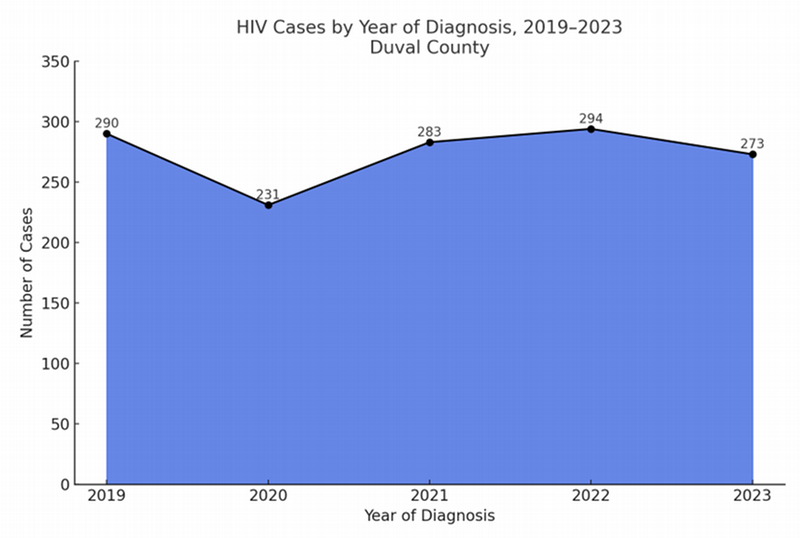
HIV Cases by Year of Diagnosis, 2019-2023, Duval County
- Number of cases in 2019: 294
- Number of cases in 2020: 234
- Number of cases in 2021: 286
- Number of cases in 2022: 293
- Number of cases in 2023: 273
The following data is new HIV diagnoses in 2023 in Duval County, Distributed by race and ethnicity. For this dataset, Black indicates non-Hispanic/Latinx. White indicates non-Hispanic/Latinx. Other race and ethnicity includes Asian, American Indian/Alaskan Native, Native Hawaiian/Pacific Islander, and Multi-race.
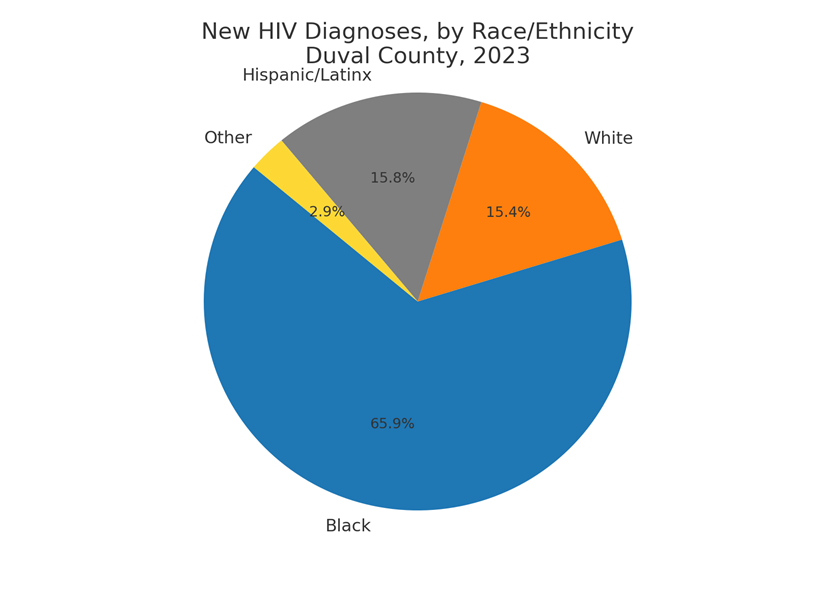
| Race/Ethnicity | Number | % of Total | Rate* |
| Black | 180 | 65.9% | 57.6 |
| White | 42 | 15.4% | 7.9 |
| Hispanic/Latinx | 43 | 15.8% | 34.7 |
| Other | 8 | 2.9 | - |
- In 2023, 180 Black individuals were diagnosed with HIV in Duval County
- For every 100,000 Black individuals in Dual County, 57.6 were diagnosed with HIV
- In 2023, 42 White individuals were diagnosed with HIV in Duval County
- For every 100,000 White individuals in Duval County, 7.9 were diagnosed with HIV
- In 2023, 43 Hispanic or Latinx individuals were diagnosed with HIV in Duval County
- For every 100,000 Hispanic or Latinx individuals in Duval County, 34.7 were diagnosed with HIV
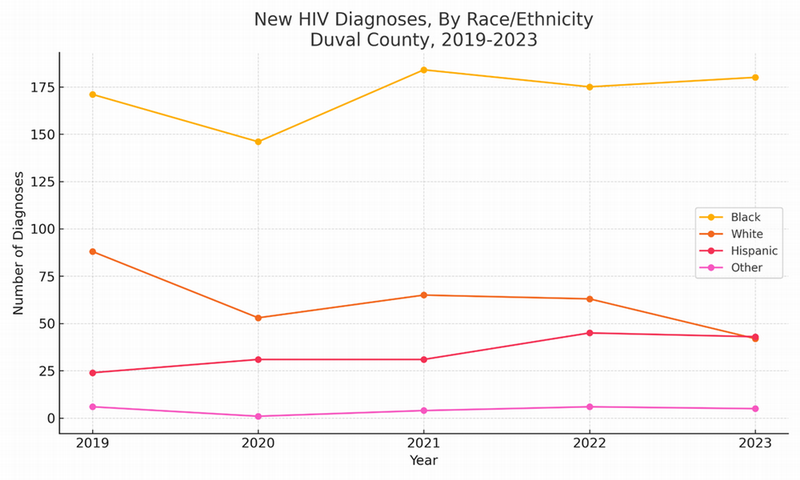
| Black | White | Hispanic | Other | |
| 2019 | 171 | 88 | 24 | 6 |
| 2020 | 146 | 53 | 31 | 1 |
| 2021 | 184 | 65 | 31 | 4 |
| 2022 | 175 | 63 | 45 | 6 |
| 2023 | 180 | 42 | 43 | 5 |
Rates are calculated per 100,000 population.
- From 2019-2023, new HIV diagnoses decreased 5.3% among Black individuals.
- From 2019-2023, new HIV diagnoses increased 79.2% among Hispanic individuals.
- From 2019-2023, new HIV diagnoses decreased 52.3% among White individuals.
In 2023, the number of diagnoses of HIV cases in Duval County, by age at diagnosis:
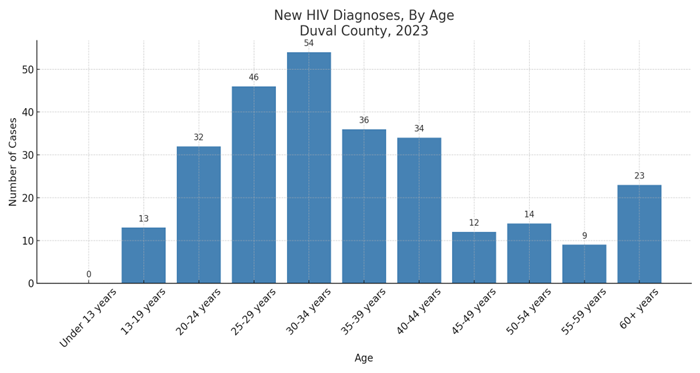
| Age (Years) | Number of Diagnoses of HIV Infection, 2023 |
| Under 13 | 0 |
| 13-19 Years | 13 |
| 20-24 Years | 32 |
| 25-29 Years | 46 |
| 30-34 Years | 54 |
| 35-39 Years | 36 |
| 40-44 Years | 34 |
| 45-49 Years | 12 |
| 50-54 Years | 14 |
| 55-59 Years | 9 |
| 60+ Years | 23 |
Newly diagnosed HIV cases are classified into the following transmission categories based on reported exposure: heterosexual contact, sexual contact among men who have sex with men (MSMSC), injection drug use (IDU), sexual contact among men who have sex with men and injection drug use (MSMSC/IDU), mother-to-child (perinatal) transmission, and other (includes blood transfusions and unknown causes).
The following is the distribution of the number of diagnoses of HIV infection in 2023 among adults and adolescents in Duval County, by transmission category. A breakdown by sex is provided, where applicable.
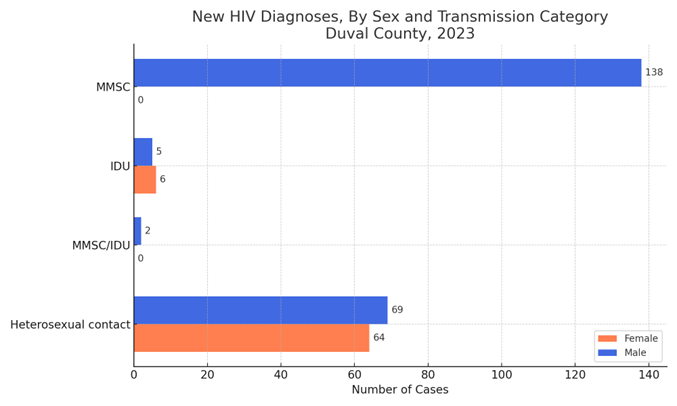
| Transmission Category | Adult and Adolescent Males |
Adult and Adolescent Females |
Total |
| MMSC | 138 | - | 138 |
| IDU | 5 | 6 | 11 |
| MMSC/IDU | 2 | - | 2 |
| Heterosexual Contact | 52 | 64 | 116 |
There were 0 reported perinatal or other exposure cases in Duval County in 2023.
AIDS prevalence is defined as the number of persons who were living with an AIDS diagnosis in the reporting area through the end of the calendar year (regardless of where they were diagnosed). Persons with HIV (PWH) and persons with AIDS (PWA) cannot be added together to get combined totals since these categories are not mutually exclusive.
By the end of 2023, an estimated number of 3,568 persons were living with AIDS in Duval County. This group is comprised of 2,291 cisgender men, 1,226 cisgender women, 49 transgender women, and 2 transgender men.
AIDS Incidence is the number of new AIDS diagnoses that occur during a specified time period. HIV diagnoses cannot be added with AIDS diagnoses to get combined totals since these categories are not mutually exclusive.
In 2023, there were 139 new diagnoses of AIDS in Duval County. Among these people, 94 were cisgender men, 44 were cisgender women, 0 were transgender men, and 1 was a transgender woman.
The following data is new AIDS diagnoses in 2023 in Duval County, distributed by race and ethnicity. For this dataset, Black indicates non-Hispanic/Latinx. White indicates non-Hispanic/Latinx. Other race and ethnicity includes Asian, American Indian/Alaskan Native, Native Hawaiian/Pacific Islander, and Multi-race.
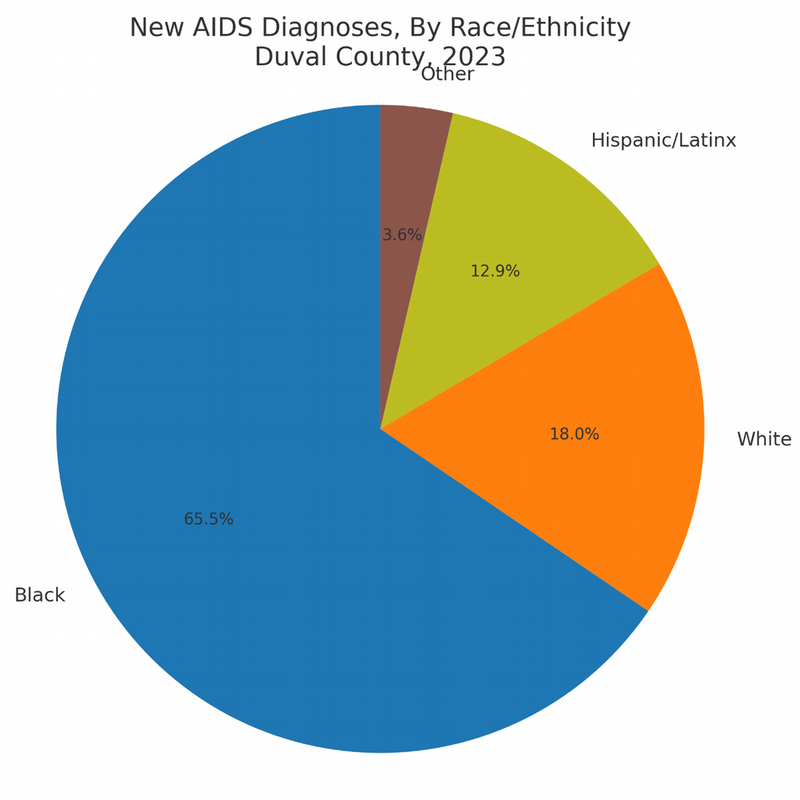
|
New AIDS Diagnoses, By Race/Ethnicity, Duval County, 2023 |
|||
|
Race/Ethnicity |
N |
% of Total |
Rate (per 100,000 people) |
|
Black |
91 |
65.5% |
29.1 |
|
White |
25 |
18.0% |
4.7 |
|
Hispanic/Latinx |
18 |
12.9% |
14.5 |
|
Other |
5 |
3.6% |
- |
In 2023, the number of cases diagnosed as AIDS in Duval County, by the time of classification, is as follows:
| Age (Years) | Number of Newly Diagnosed as AIDS Cases, 2023 |
| Under 13 years | 0 |
| 13-19 years | 1 |
| 20-24 years | 9 |
| 25-29 years | 13 |
| 30-34 years | 24 |
| 35-39 years | 15 |
| 40-44 years | 19 |
| 45-49 years | 14 |
| 50-54 years | 8 |
| 55-59 years | 13 |
| 60+ years | 23 |
This section pertains to Florida in 2023. HIV diagnoses cannot be added with AIDS diagnoses to get combined totals since these categories are not mutually exclusive. Similarly, Persons with HIV (PWH) and persons with AIDS (PWA) cannot be added together to get combined totals since these categories are not mutually exclusive.
- A total of 4,725 HIV cases were diagnosed in Florida in 2023 with a rate of 20.8 per 100,000 population.
- Of the new HIV diagnoses, 975 were White, 2,129 were Black, 1,545 were Hispanic, 47 were Asian, 4 were American Indian/Alaska Native, 1 were Native Hawaiian/Pacific Islander, and 24 were multi-race.
- There were 1,981 new diagnoses of AIDS and 61,863 people living with AIDS in 2023.
- Of the 128,497 people living with HIV in Florida in 2023, 43.0% were Black, 27.0% were White, 27.9% were Hispanic, and 2.1% were other races and ethnicities, including multiracial.
- There were 550 HIV-related deaths in 2023. 54.0% of deaths were in the Black population.
- 79.0% of the 128,497 people living with HIV were in care in 2023.
- 88.0% of people living with HIV who were in care with a suppressed viral load.
- 90.6% of people living with HIV who were retained in care had a suppressed viral load.
- 21% of people living with HIV did not receive any care in 2023.
These are the counties in Florida reporting the highest number of HIV diagnoses in 2023:
|
Florida Counties, by Number of New HIV Diagnoses |
||
|
Rank |
County |
# Cases |
|
1 |
Miami-Dade |
1,048 |
|
2 |
Broward |
461 |
|
3 |
Orange |
423 |
|
4 |
Hillsborough |
378 |
|
5 |
Palm Beach |
282 |
|
6 |
Duval |
273 |
|
7 |
Pinellas |
164 |
|
8 |
Polk |
158 |
|
9 |
Lee |
104 |
|
10 |
Leon |
90 |
These are the counties in Florida reporting the highest rate of new HIV diagnoses in 2023. Rates are calculated per 100,000 population.
|
Rank |
County |
Rate |
|
1 |
Miami-Dade |
37.6 |
|
2 |
Leon |
29.8 |
|
3 |
Broward |
29.4 |
|
4 |
Hamilton |
39.4 |
|
5 |
Monroe |
28.6 |
|
6 |
Bay |
28.2 |
|
7 |
Orange |
27.7 |
|
8 |
Duval |
26.0 |
|
9 |
Gadsen |
24.9 |
|
10 |
Hillsborough |
24.3 |
From 2019 to 2023, HIV diagnoses in Duval County:
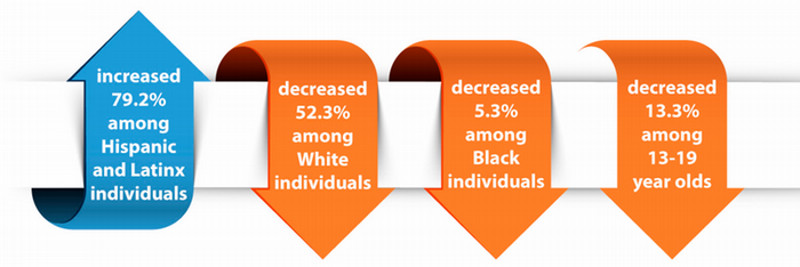
- Increased 79.2% among Hispanic and Latinx individuals
- Decreased 52.3% among White individuals
- Decreased 5.3% among Black individuals
- Decreased 13.3% among 13-19 year olds
This chart depicts new HIV cases, organized by race and ethnicity, from 2019 to 2023 in Duval County. For this dataset, Black indicates non-Hispanic/Latinx. White indicates non-Hispanic/Latinx. Other race and ethnicity include Asian, American Indian/Alaskan Native, Native Hawaiian/Pacific Islander, and Multi-race.

This chart depicts new HIV diagnoses in adults, distributed by age at diagnosis, from 2019 to 2023 in Duval County. For surveillance purposes, adult diagnoses represent persons aged 13 and older.
